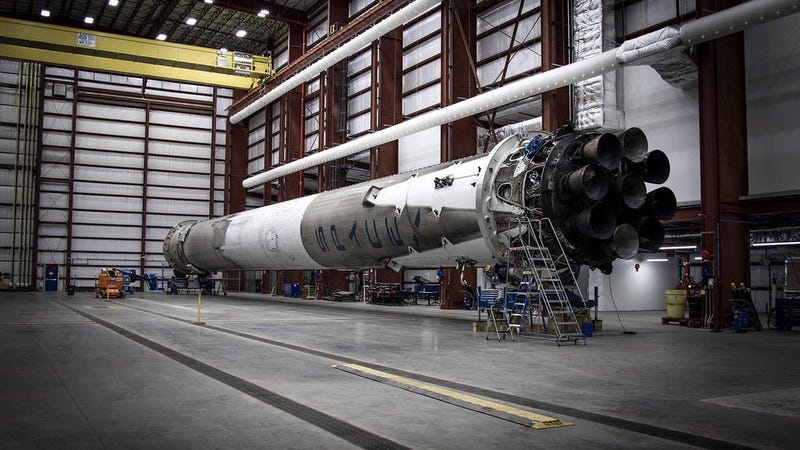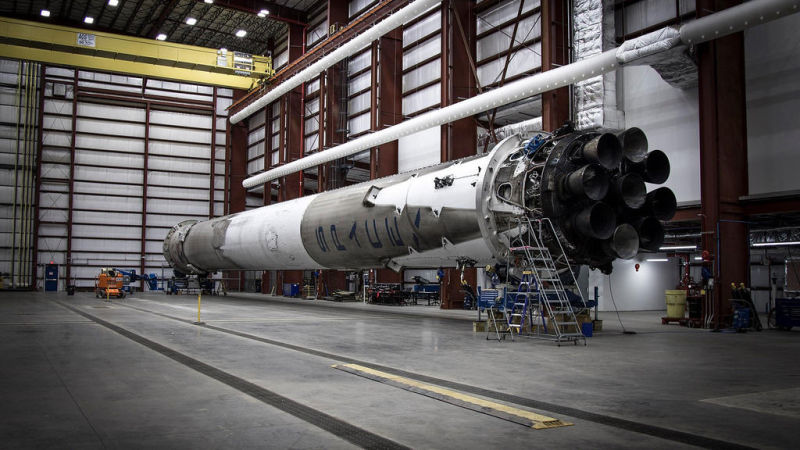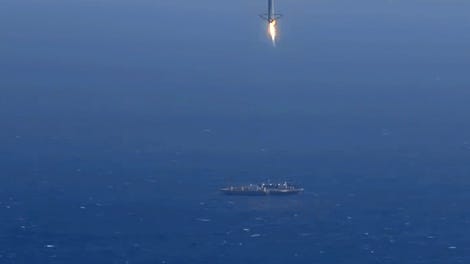
Since its inception, SpaceX has been working toward developing reusable rockets. From a fiscal standpoint, the move makes a tremendous amount of sense: Not having to pay tens of million dollars to build a new first stage booster every time you launch is cost-effective, and would make launches a hell of a lot easier as a result. On Thursday, SpaceX will finally take the plunge—or rather, launch—and attempt to send off and land a Falcon 9 rocket that was used last April to send a Dragon cargo capsule to the International Space Station (ISS).
Advertisement
If SpaceX is successful, this will mark the first time a reusable rocket has ever been launched into orbital space and landed upright.
“If one can figure out how to effectively reuse rockets just like airplanes, the cost of access to space will be reduced by as much as a factor of a hundred,” Musk is quoted as saying on SpaceX’s website. “A fully reusable vehicle has never been done before. That really is the fundamental breakthrough needed to revolutionize access to space.”
Advertisement
Since December 2015, the company has successfully landed Falcon 9 first stages on eight separate missions, first at land and later, in a more technically challenging feat, on a drone ship at sea. It charges companies roughly $60 million to carry a payload, but in the case of this week’s launch, SpaceX cut European-based telecom satellite operator SES a steep discount due to the refurbished rocket, according to a report by Spaceflight Now. If all goes according to plan, without any delays, mishaps or explosions, the Falcon 9 will ferry the SES-10 communications satellite into orbit later this week.
Reusability makes a lot of sense—so why has it taken the aerospace industry so long to achieve? To be fair, Jeff Bezos’ aerospace company, Blue Origin, successfully launched and landed its New Shepard rocket on five separate occasions in less than a year—but those were all suborbital flights. It’s also worth noting that NASA’s Space Shuttle, with its twin solid rocket boosters, was also a reusable launch vehicle. Still, no one—and there are a lot more companies in the rocket game than there were when SpaceX was founded in 2002—has yet to ace an orbital mission with a reusable rocket that lands upright.
“With the launch this week, what’s being reused is the first stage,” Bobby Braun, dean of the College of Engineering and Applied Science at the University of Colorado Boulder, told Gizmodo. “So when we say ‘reusable rockets,’ ultimately, what the industry is building toward is a completely reusable rocket, so we’d reuse the first stage, the second stage, etc. But the first stage has the biggest and the most expensive engines.”
Sponsored
Reusing rockets could lead to cheaper launches for commercial satellites and government partners—SpaceX has hinted at giving its customers discounts of up to 30 percent for reusable rockets. And ultimately, if we’re going to send loads of humans live on Mars, as Elon Musk clearly intends to, we need much cheaper systems for launching payloads into orbit.
“If a company like SpaceX, Blue Origin or NASA or the airforce can reduce the cost of launch, it has a major ripple implication across the whole space enterprise,” Braun said. “The launch is exciting in and of itself, and I think the whole space community is rooting for SpaceX to be successful, not only on its own merits, but because of this ripple [a successful launch] could have across the whole economy.”
Advertisement
Things are generally looking good for the big launch. On Monday, SpaceX conducted a successful static fire test of the Falcon 9 booster on pad 39A at NASA’s Kennedy Space Center in Florida. Braun feels optimistic, too.
“I think the odds of success are very good. I think they’re the same as if it was the first time a system was being used. Spaceflight is a risky proposition…but you’d put a reused first stage through the same process you would with a new first stage. And if it passes the test, it’s spaceflight qualified.”
The launch window begins Thursday at 6pm EDT and closes at 8:30pm EDT. We’ll be watching—as always, ad astra, SpaceX!
















